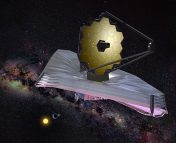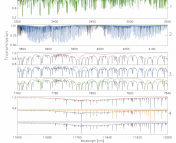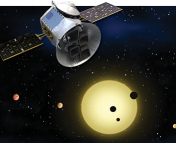Title: Hazy with a chance of star spots: constraining the atmosphere of the young planet, K2-33b
Authors: Pa Chia Thao, Andrew W. Mann, Peter Gao, et al.
First Author’s Institution: Department of Physics and Astronomy, UNC Chapel Hill
Status: Accepted to the Astronomical Journal, available on arXiv.
As all ground-based astronomers can tell you, cloudy and hazy skies are the bane of good observations. Imagine hearing there’s a new supernova out that needs immediate follow-up, and you can’t see it because there’s a thick layer of clouds hanging out over your observatory. You’d think that space telescopes, which spend their entire productive lives above the Earth’s atmosphere, would be free of such frustrating phenomena, but no! Exoplanetary atmospheres are just as likely to be obscured by all sorts of science-blocking aerosols, making it hard to see any identifiable features from gases (like water vapor or carbon dioxide) in the planet’s atmosphere (a so-called “flat spectrum”). What happens if a planet’s flat spectrum isn’t truly flat, though? What if there aren’t any molecular features but there are some puzzling differences at different wavelengths? Can we pull any useful information out of a featureless planet? Today’s authors make the case that we absolutely can.
K2-33 b is the youngest transiting planet known (only 10 million years old!), a super-Neptune sized planet, orbiting a 3500K M3 dwarf, 140 parsecs away from Earth in the constellation Scorpius. Since its discovery by the Kepler spacecraft in 2014, it’s been the subject of a significant number of followup observations, including 10 transits with Spitzer, a spectrum based on a partial transit from Hubble, and a dozen transits from the two MEarth Project observatories. Taken together, all of these observations can be used to construct a low-resolution transmission spectrum of the planet ranging from 0.6 to 4.5 microns. Data from Hubble’s near-infrared spectrographs show a relatively flat spectrum between 1.1 and 1.7 microns with no significant features indicating water vapor or any other identifiable molecules. However, the observed transits of this planet are nearly twice as deep at short wavelengths compared to long ones! Two major possibilities exist to explain the significant slope in the full spectrum: either this is the result of an inhomogeneous stellar surface, or the spectrum is showing something physical in the planet’s atmosphere.
Figure 1: The various transits of K2-33 b. The optical transits (K2, MEarth) are nearly twice as deep as the near-infrared transits (Spitzer, Hubble), which raises interesting questions about the planet’s atmosphere. Figure 5 in the paper.
Spots Aren’t Just for Cheetahs
One important thing to be aware of during transmission spectroscopy is the stellar reference spectrum. Transit spectra rely on a good understanding of the stellar surface while the planet is not transiting, so starspots (where the surface is cooler and darker) and plages (where the surface is hotter and brighter) could have significant effects on these observations. For example, a transit crossing a starspot would appear shallower than normal, but a transit that coincides with visible starspots (but doesn’t cross them), would look deeper than normal. Starspots tend to come and go with the star’s rotation over long periods of time, so modeling these accurately is important to interpret data from transits separated by weeks and months.
Figure 2: Top – Starspots can change a star’s observed spectrum enough to significantly affect an exoplanet’s transmission spectrum, producing false absorption features. (Fig. 1 in https://arxiv.org/abs/1711.05691) Bottom – High altitude clouds and hazes block incident starlight from filtering through a planet’s atmosphere, flattening out its transmission spectrum. (Fig. 1 in Kempton, E.M.R., 2014, Nature, 513, 493)
Alien Smogs
The other major possible explanation for the strongly sloped spectrum is the effects of spectrally-dependent hazes in the planet’s atmosphere. Hazes should be present in planetary atmospheres as small molecules break up and polymerize under stellar radiation at high altitude. While clouds are often modeled as uniform absorbers, small haze particles tend to more strongly absorb at shorter wavelengths, leading to marked slopes going from the optical into the IR. Warm gaseous planets like K2-33b are expected to have complex carbon chemistry, with visible traces of methane (CH4) or carbon monoxide (CO) depending on temperature and the amount of mixing in the atmosphere. Cooler atmospheres should have more CH4 than CO, but hotter atmospheres or mixing of hotter, deeper parts of the atmosphere up to higher altitudes can increase the amount of CO. These carbon species can be turned into hazes like tholins and soots, similar to smog produced by burning fossil fuels. The authors modeled the effects of both types of hazes produced by both CH4 and CO, leading to four possible atmospheres to fit the data.
¿Por qué no los dos?
After some detailed stellar and planetary atmospheric modeling, the authors found that neither starspot coverage nor atmospheric hazes alone were sufficient to explain K2-33 b’s observed transmission spectrum. Including both spots (either a modest spot coverage of <20% of the surface, or the spots must be similar to the stellar surface temperature) and hazes (CO-derived tholins) gave the best fit to the data. K2-33 b is not quite hot enough to expect lots of high-altitude CO, so finding that CO-derived tholins fit the data best is surprising. The preferred explanation for the presence of CO over CH4 is atmospheric mixing, but the planet may also have a higher than expected metallicity and a lower C/O ratio, which will need further observations with JWST to confirm.
Figure 3: Best fit atmospheric models to K2-33 b’s observed spectrum. The models including starspots fit the data better than those not including spots, and the CO tholin model fits the observed Spitzer photometry better than the soot. Figure 12 in the paper.
Putting a Ring on it
What if neither sunspots nor hazes were the real explanation, though? One final possibility is the presence of a large planetary ring, something often theorized but never observed outside of our own solar system. Close orbiting young planets can maintain rings, and ring particles of ~1 micron could easily reproduce the deep optical transit while allowing for shallower parts of the spectrum in the near-IR. For more information on this intriguing possibility, check out yesterday’s Astrobite!
Astrobite Edited by Aldo Panfichi
Featured Image Credit: ESA/A.Gerst




